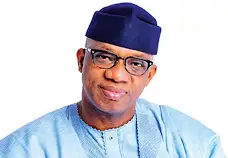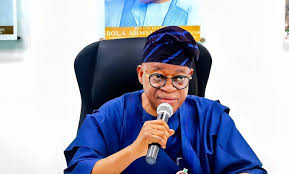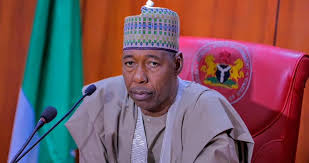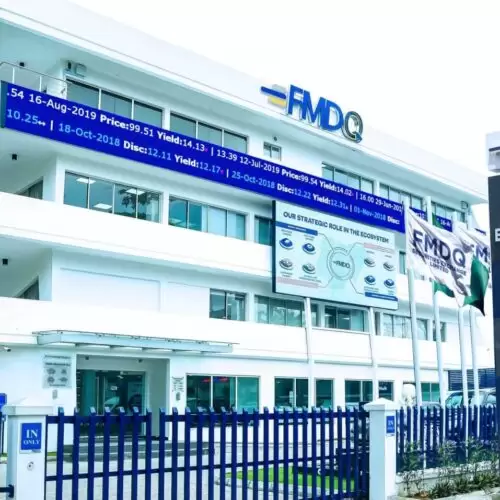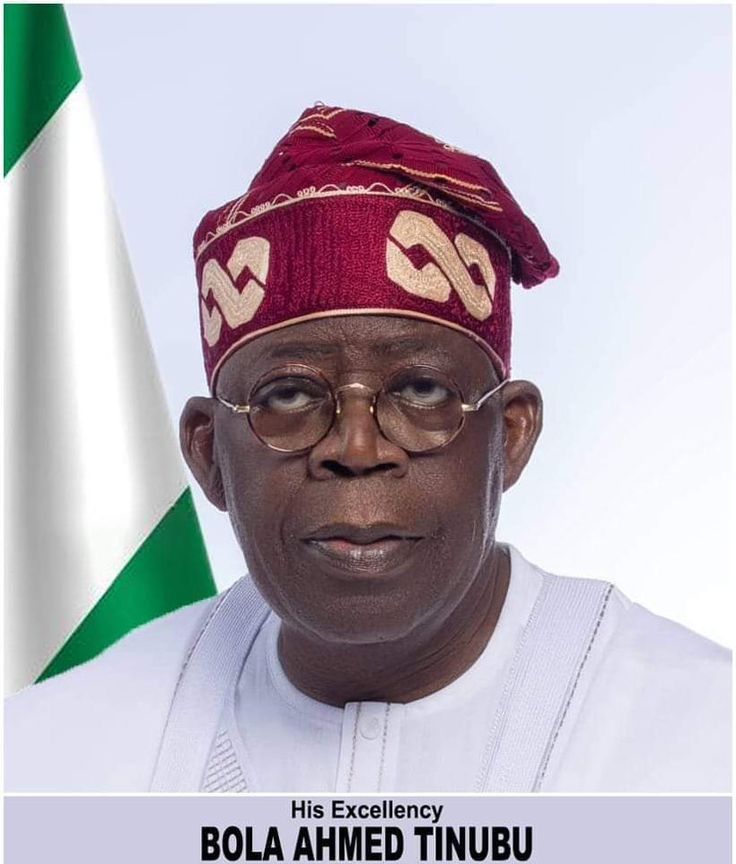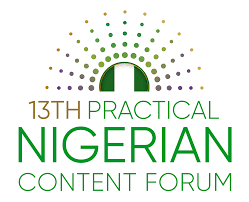©2022 DopeReporters. All Right Reserved. Designed and Developed by multiplatforms
Tag:
Technology
Plans are in top gear by the Ogun State Government to leverage the use of technology and the Internet to produce, distribute, and generate clean, quality water for residents.
The Special Adviser to the Ogun State Governor on SDG and Water Resources, Hon. Damilola Otubanjo, made this known during an assessment tour of water generation facilities in the state capital.
Otubanjo also said that the state government will continue to pay a lot of attention to quality assurance, adding that there are several plans by the government to ensure that the water corporation isn’t just producing water but producing it sustainably.
“We need to have the process flow to make things more automated, and we need to explore the Internet to see how we can leverage technology to make our processes more efficient.
“There is a need for us to adopt advanced technology; some of the processes are a bit outdated, so we need to look at how we can optimize and make them more efficient.
“There are a lot of challenges; clearly, there are many areas in the space of maintenance. We need to pay a lot of attention to quality assurance because during my tour, I engaged with the team to understand the quality processes and the testing that they have to conduct,” she said.
The Special Adviser also noted that the state government is planning to convert its several customers across the state who are still on flat and post-paid rates to pre-paid rates, saying that the conversion would help the corporation and the state government gain significant value from the water they are producing.
Otubanjo further said that the state water corporation has a high level of non-revenue water due to the lack of appetite from customers who are not paying because they don’t receive the water they need.
She added that the state government would look at the possibility of installing sensors and meters to measure the quality and quantity of water that is being produced in order to properly estimate what its revenue should look like.
“There is also the issue of metering. We need to convert our customers who are on flat rates and post-paid plans to pre-paid plans. That way, we can gain significant value from the water we are producing.
“So, when we install pre-paid meters, it means you only pay for what you consume. They won’t suffer any sense of loss because they only pay for what they consume, so we need to make our system more efficient,” she said.
The Special Adviser assured the people of the state of immediate improvement in the distribution of water, also affirming that the corporation would do a lot in terms of advocacy and awareness.
Otubanjo also stated that the corporation’s response to bursts and leakages of its pipes across the state would be optimal, urging members of the public to be collaborators in progress.
“I can assure the people of the state that they will see improved water service. Largely, there is a need for us to create a lot of awareness. To reinstate the confidence and trust of the people back in the Ogun State Water Corporation, we need to do a lot in terms of advocacy and awareness. We need to be accessible, reachable, and we need to communicate.
“Our response to bursts and leakages must be optimal. Within 24 hours, we should be able to respond, and I want to call on the members of the public to be collaborators in progress.
“We have our toll-free line (07080601161) that they should reach out to us on to report issues, and I promise that we will respond promptly,” she added.
On her part, the Consultant to the Governor on Water Resources, Mrs. Olufunmilayo Jaji, noted that water production is not limited to Abeokuta alone, adding that the state has Papa Water Works that supplies Papalanto, Ilaro, and Ifo, Ota 2 that supplies Ota, the Ijebu-Ode Yemoji scheme, and Apoje that supplies water to Ijebu-Igbo and Ago-Iwoye, as well as borehole schemes across the state.
Jaji urged the people of the state to pay their water bills on time, even as she tasked them to report timely information on burst water pipes to prevent contamination of clean water supply.
The Chairman of Workers’ Estate, Laderin, Abeokuta, Mr. Olatunji Oladapo, commended the state government for showing a willingness to put an end to the issues of burst pipes in the estate, adding that the visit would go a long way in ensuring that the estate continues to enjoy uninterrupted water supply.
Some of the areas visited include Oke-Temidire Water Reservoir in Abiola Way, Ogun State Water Corporation (old and new schemes) at Arakanga, Alamala booster station, Car Wash booster station, Panseke booster station, Ibara booster station, Abeokuta area office, and the Laderin Borehole scheme.
The Minister of Marine and Blue Economy, Adegboyega Oyetola, says Nigeria has commenced the deployment of advanced technology to enhance its global competitiveness in maritime trade.
The minister made this remark on Wednesday, during the inauguration of the new executive committee of the Nigerian Institution of Facilities Engineering and Management, NIFEngM, in Port Harcourt.
Oyetola, represented by Peter Mbam, Director of Legal Services in the ministry, affirmed that the adoption of cutting-edge technology was part of the President Bola Tinubu’s administration’s commitment to the blue economy initiative.
According to him, facility engineers play a critical role in the design, construction, operation, and maintenance of physical infrastructure for the marine and blue economy sectors.
“An inspiring example of the importance of facilities engineering in the blue economy initiative is the recent innovative development of the Lekki Deep Sea Port.
“This project exemplifies how cutting-edge engineering and effective management can boost Nigeria’s global competitiveness in maritime trade.” Oyetola noted.
He explained that the blue economy involved the sustainable utilisation of ocean resources to promote economic growth, improve livelihoods, create jobs, and preserve the health of marine and coastal ecosystems.
Oyetola added that the Federal Government was working closely with facility engineers to leverage on technology to build smarter and more resilient infrastructure across the country.
“Smart technologies, such as the Internet of Things, Artificial Intelligence, and big data, are revolutionising facilities management, and we are leveraging these innovations to improve our infrastructure,” he said.
The minister further reiterated the government’s commitment to the United Nations Sustainable Development Goals (SDG), which underscores the importance of facilities engineering in achieving SDG 7, 9, and 14.
He expressed confidence that the newly inaugurated NIFEngM executive committee would collaborate with the government to enhance the nation’s blue economy initiatives.
“Collaboration with facilities engineers will help drive the Renewed Hope Agenda of President Tinubu.
“Together, we can advance the frontiers of facilities engineering and management for the benefit of our nation and future generations,” Oyetola said.
The Nigerian Navy pursued the oil tanker MT Heroic Idun into the Gulf of Guinea. Navy officials suspected the ship of stealing oil from a Port Harcourt terminal. The tanker’s crew, mistaking the approaching naval patrol boat for pirates on that day in August 2022, reported themselves under attack and fled.
Using the tools of the Yaoundé Architecture Regional Information System (YARIS), Nigerian authorities contacted their counterparts in Equatorial Guinea, who impounded the ship when it entered their waters and held the crew as suspected thieves.
Although the crew eventually was acquitted of wrongdoing, the incident illustrates how African nations use technology and regional organizations to improve maritime domain awareness (MDA) along the continent’s heavily traveled Atlantic and Indian oceans’ coasts.
“Nigeria is a prime example of a country where investment in technology-based infrastructure has helped it to tackle threats to security and development,” analyst Ifesinachi Okafor-Yarwood wrote recently in The Conversation. Okafor-Yarwood has written extensively about the nexus between technology and maritime security, particularly in the Gulf of Guinea.
Nigeria is a West African maritime security leader. Among its MDA tools, the Falcon Eye system uses a network of radars, electro-optic systems and cameras to track vessel movements. Along with Falcon Eye, the Deep Blue Project includes a fleet of 19 ships, unmanned aerial vehicles, 600 coastal security personnel and a land-based Command, Control, Communication, Computer, and Intelligence Centre to collect data and respond to incidents.
Nigeria credits its effort to monitor and protect its offshore territory for a steep drop in piracy incidents and a delisting in 2022 from a public roster of the world’s piracy problem areas.
Nigeria has the capability to fund its own MDA system, but many nations cannot. Regional systems such as YARIS and its Indian Ocean analog, the Djibouti Code of Conduct, improve MDA by encouraging countries to work together to overcome their individual deficiencies.
Despite that, the systems face important challenges, such as long-term sustainability and building trust with shippers, according to former shipping executive Sam Megwa, who now oversees the Gulf of Guinea Interregional Network, which is working on ways to ensure the future of YARIS.
“We need to foster cooperation and trust,” Megwa said during an interview on Okafor-Yarwood’s podcast, “AfriCan Geopardy.” “If the maritime environment is secure, it benefits everyone.”
TECHNOLOGY AND TRUST
Africa’s 39 coastal countries are responsible for 48,100 kilometers of coastline, 13 million square kilometers of exclusive economic zones and more than 100 ports — a huge amount of territory that countries historically have struggled to patrol effectively. It’s a condition researchers refer to as “sea blindness.” The result has been decades of piracy, trafficking and other challenges to the continent’s sea-based economy.
“Oceans remain an elusive space for many coastal states due to limited capacity resulting from lack of access to infrastructure, technology and technical know-how,” Okafor-Yarwood wrote as the lead author of a study published in the journal “Marine Policy” in early 2024.
The situation has begun to change as technological advancements, including internet-based, land-based and space-based systems, give countries a better understanding of what is happening in their territorial waters.
“The evolution of MDA is intrinsically linked to the rise of technologies promising to enhance states’ surveillance capabilities,” Okafor-Yarwood and his coauthors wrote in Marine Policy.
Technology that African nations have at their disposal includes:
SeaVision: The unclassified MDA tool created in the United States in 2012 requires only an internet connection, username and password. It lets users track commercial vessels globally with data from automatic identification system (AIS) transponders developed to prevent collisions at sea. About 25 African countries use the tool.
Radar: Low-cost land-based radar systems that can see through bad weather give authorities a picture of the ships operating in their waters. However, such systems see small slices of territory at a time and cannot provide the kind of identifying information available from AIS or the vessel monitoring system.
Satellite: Satellite images cover large amounts of territory, but their low resolution makes it difficult to see small vessels. Like radar, they also fail to provide identifying information. Subscriptions can be too expensive for some countries.
Skylight: This internet-based system combines public and private satellite images and AIS data to locate ships and track them at sea with an emphasis on illegal, unreported and unregulated (IUU) fishing.
Synthetic-aperture radar: This high-cost satellite-based radar system provides higher resolution images than land-based radar and can pinpoint vessels’ position and activity. It also can track vessels that have disabled their AIS transponders — a tactic common to ships fishing illegally.
Vessel Infrared Imaging Radiometer Suite: This technology detects vessels based on the light they emit, making it particularly effective against IUU fishing vessels that use lights to attract fish.
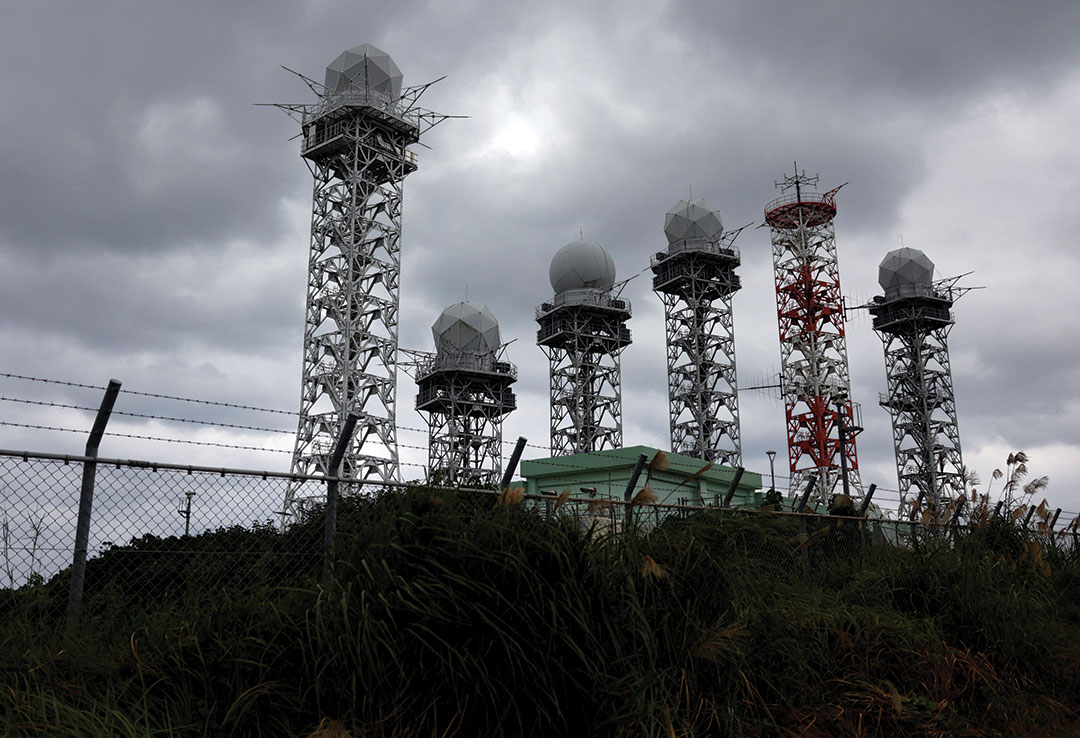
Even as maritime technology proliferates, it’s no substitute for coordination and collaboration among countries.
“The struggle to patrol is largely caused by a lack of capacity, which could be overcome if authorities would improve joint awareness through shared information,” analyst Timothy Walker wrote for the South Africa-based Institute for Security Studies.
That said, information must be shared judiciously in areas where it might encourage corrupt authorities to collude with the same criminals the systems are trying to stop, according to experts.
“This creates a culture of mistrust,” Okafor-Yarwood and co-authors wrote in “Marine Policy.”
African nations already struggle to instill trust in the commercial shippers that transit their waters. Ships that suspect piracy often report first to groups such as the Malaysia-based International Maritime Bureau rather than to the nearby information centers established by the Yaoundé and Djibouti systems. In many cases, ship captains don’t believe African nations will respond effectively, according to researchers.
“It goes without saying that contacting the region first would give them the best chance of responding quickly and effectively to ships in distress,” Megwa said. “The full potential of YARIS cannot be realized unless there is that information sharing between the ships and the regional centers.”
CHALLENGES AHEAD
Collaboration in the maritime environment can overcome the limitations some nations face, particularly those where land-based insurgencies and terrorism force leaders to shift their focus away from the largely out-of-sight offshore areas. For those, the Yaoundé Architecture or Djibouti Code of Conduct can be a vital part of their effort to disrupt maritime crime.
From its founding in 2008, the Djibouti Code of Conduct became the cornerstone of international efforts to rein in piracy in the western Indian Ocean, a region that includes the Gulf of Aden, the Gulf of Oman and the Mozambique Channel, three crucial chokepoints for the global economy.
Over the next decade, the 20 signatories — 15 African and five Middle Eastern nations — and their partners reduced piracy levels to virtually zero in the region. In 2022, the International Maritime Organization delisted the Indian Ocean as an area at high risk for piracy.
Although piracy has dropped dramatically, African nations continue to face other ocean-borne challenges. Drug traffickers, for example, have made the continent a key transit route to Europe, from Brazil into West Africa and from southern Asia into East Africa. Africa’s Indian Ocean nations alone experience more than $190 million in drug trafficking each year, according to researchers Darshana M. Baruah, Nitya Labh and Jessica Greely with the Carnegie Endowment.
“The movement of drugs and terrorism are connected,” the researchers wrote in a 2023 study.
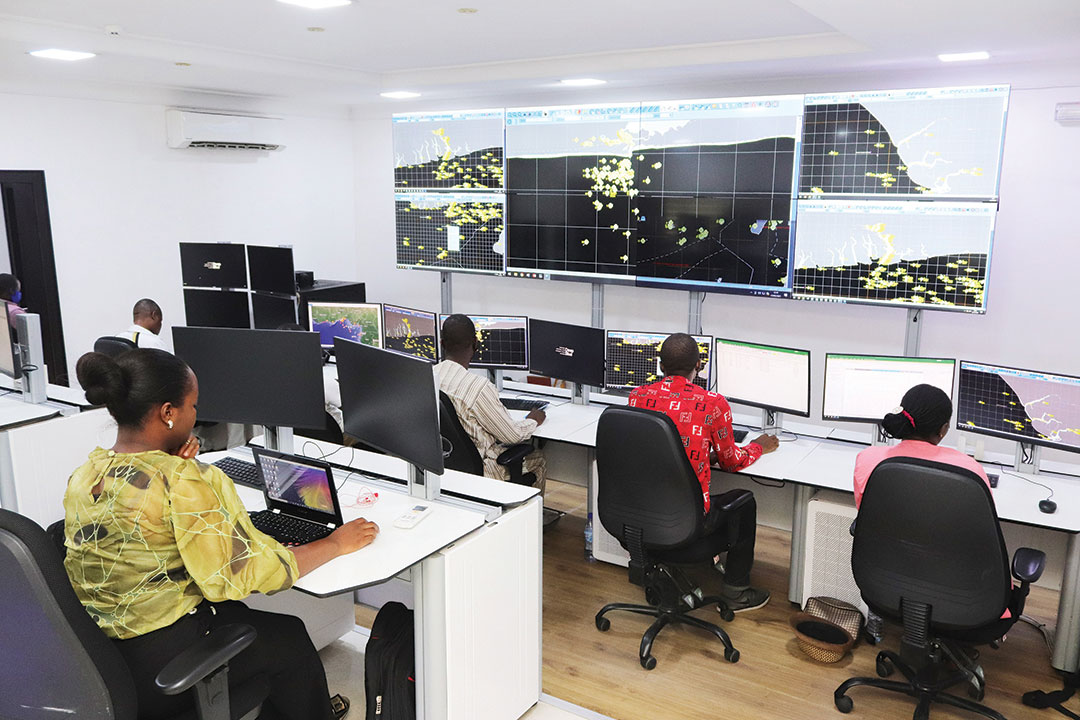
Since 2016, East African regional maritime security forces repeatedly have intercepted Iranian weapons destined for al-Shabaab and the Islamic State group in Somalia.
Africa’s Indian Ocean island nations — Madagascar, Mauritius and Seychelles — are responsible collectively for monitoring more than 3.8 million square kilometers of ocean, second only to Australia, making regional cooperation imperative. Madagascar is home to one of three Indian Ocean information fusion centers designed to collect data and coordinate MDA across the region.
Even as nations use technology and collaborative agreements to improve their MDA, they face important challenges going forward. Chief among those is the future of YARIS, which relies on funding from the European Union.
According to Megwa, YARIS’s future may require a combination of public and private funding to ensure the system remains sustainable. That includes finding an African location to host the system’s data center, which is in Portugal.
“There is no point in handing the system over to the region then having YARIS fail because there are other priorities,” Megwa said. “It will be very much a collaborative effort.”
The region also has a lack of trained people to take the reins of YARIS, which already struggles to get member nations to fully staff its information centers, according to researchers.
To avoid potential backsliding on marine security, Okafor-Yarwood and others say that African nations must put more attention and resources into guarding their coastal zones.
“Security technologies that focus on threat identification are only effective if law enforcement officials have the necessary resources to interdict these threats,” Okafor-Yarwood and coauthors wrote. “The role of technology in MDA and maritime security capacity is crucial and undeniable.”
The post Technology Boosts Maritime Security first appeared on Africa Defense Forum.
The post Technology Boosts Maritime Security appeared first on Africa Defense Forum.
In an increasingly digital world, connectivity is a necessity. Yet, nearly a third of the global population remains offline, unable to access the services vital to participating in our global digital economy and society. The Edison Alliance at the World Economic Forum has worked to change that by delivering digital connectivity and access to financial, healthcare, and education services to those who need them most. Our partnerships with governments, industries, and non-governmental organizations drive lasting systemic change.
The World Economic Forum played a pivotal role in launching and guiding the Alliance’s work, providing a platform for stakeholders to come together and commit to a vision with actionable ideas and plans. CEOs, ministers, and heads of international organizations harnessed the power of public-private partnerships and gathered to discuss the barriers to connectivity and identify scalable solutions.
The 1 Billion Lives Challenge, achieved by the Edison Alliance in 2024, one year ahead of schedule, exemplifies what can be achieved when diverse stakeholders work toward a common goal. Through partnerships with telecom providers, financial institutions, technology companies, and policymakers, the Alliance delivers impactful programs worldwide. In India, we are using digital tools to connect rural communities to vital health services. In Africa and the U.S., mobile banking solutions empower millions of unbanked individuals with access to financial services. In Latin America, digital literacy initiatives opened new educational opportunities for often underrepresented populations.
Each of our efforts underscore the profound impact of digital connectivity. For the rural farmer in Kenya, it means access to real-time market information that can increase yield and revenue. For the student in a remote village in Peru, it means access to online learning platforms and global educational resources. For the small business owner in Indonesia, it means the ability to reach new markets and grow. Connectivity, quite simply, is the key to unlocking potential and reducing inequality.
Achieving the 1 Billion Lives Challenge is not just a milestone, as every life touched is a life improved and a call to further action. It demonstrates that global challenges—no matter how complex—can be addressed when we come together with purpose and determination. But our work is far from over. While one billion people have better and more comprehensive access to our digital world, billions more still lack access to these critical digital tools. And, the adoption of AI and Generative AI tools threatens to further widen that gap. The digital divide remains one of the most pressing issues of our time, and the Alliance is committed to continuing its efforts to close it.
The World Economic Forum will remain a critical organization for advancing our work. It is a place where leaders are not only inspired to think big but are also held accountable for delivering on their commitments. The Forum’s unique structure, which emphasizes multi-stakeholder collaboration, ensures that progress is not just discussed but achieved. It is in this spirit that the EDISON Alliance was born, and this is the spirit that will launch further efforts to expand access to vital resources and opportunities. Our work will continue through new initiatives like the World Economic Forum’s AI for Prosperity and Growth in Africa, launched at this year’s Annual Meeting.
Looking ahead, we see a world where connectivity is available to all who want it. This vision requires sustained effort, innovation, and investment. It requires us to address the structural barriers that perpetuate the digital divide, from affordability and infrastructure to digital literacy and policy frameworks. It requires us to keep asking tough questions and pooling our resources to push the boundaries of what is possible. We call on the public and private sectors to increase their collaboration so we can meet these bold ambitions. Together, we will build a world where no one is left behind in the digital age.
AHMED MARI, Maiduguri
The Borno state Governor, Prof Babagana Zulum has reiterated his administration’s commitment to prioritize technology and digital space in land management and administration.
Speaking at a commissioning of some projects at the BOGIS headquarters, Maiduguri on Thursday, Governor Babagana Zulum commended the chairman, and members of the board, Executive Secretary, Management and staff of the service for transforming the land administration and management in the state.
” These projects we are about to commission were executed through the meagre 5 percent being remitted to the service. “Within the last 5 years the BOGIS has generated over N5 billion” Zulum Said.
He ordered the state Head of Service to liase with the Executive Secretary of the service to posch staff from.the civil service to address the issue of inadequate manpower, as well as recruit more staff if the need arises.
Zulum called on the people of the state to pay their ground rent as and at when due as failure to do so will attract severe penalty, adding that it is from the Internally Generated Revenue (IGR), that the government executes projects.
“Just last Monday, the state Executive Council in it’s maiden meeting of the year 2025 approved the released of over N40 billion for the dualization of the roads linking Gomari roundabout to Muhammadu Buhari International Airport”, the Governor said.
In his welcome address, the chairman of the BOGIS, Alhaji Zanna Mahdi urged the Governor to grant approval for the recruitment of staff to address the problem of inadequate staff, provision of utility vehicles to go for the day to activities of the service and training and retraining of staff.
In his remarks, the Executive Secretary of the BOGIS, Engr Adam Bababe revealed that from the inception of the service in the year 2020 the Governor has signed over 2500 Certificates of Occupancy compared to 1,700 from 1999 to 2019.
He said the 180 seater capacity auditorium will be used for training of staff, engagement with stakeholders, and board meetings among other activities of the services.
For a better society
_______________________________
Follow us across our platforms:
Instagram – https://www.instagram.com/championnewsonline/
Facebook – https://web.facebook.com/championnewsonline
LinkedIn – https://www.linkedin.com/company/champion-newspapers-limited/
https://x.com/championnewsng/
You can also like and comment on our YouTube videos.
https://youtu.be/QIBfD1tT80w?si=R4Qf3so2LxYu3GC2
It shouldn’t have taken a tragedy to launch a national conversation about our broken healthcare system and the pain it causes. But the question now is how can we use this moment of collective focus to fully acknowledge how poorly the American public is served by our healthcare system? And what can be done to fix it? Technology has the potential to be part of the solution—or to exacerbate existing issues.
The ripple effects of the killing of UnitedHealthcare CEO Brian Thompson have been significant. Shares of UnitedHealth Group dropped by nearly 15% in the days following the shooting. And shares of other insurers, like Cigna and Humana, also dipped. The day after the shooting, Anthem Blue Cross Blue Shield announced it would halt its controversial plan to limit reimbursement for anesthesia for surgeries that went over certain time limits.
The attack also sparked renewed anger at our broken healthcare system. It’s not hard to see why people are furious. A 2023 American Medical Association (AMA) survey found that 94% of doctors said prior authorization requirements delayed care, and 78% said this sometimes caused patients to give up seeking treatment altogether. Nearly one in four said prior authorization requirements had led to serious adverse outcomes for patients. According to an Experian survey, denials of health claims increased 31% between 2022 and 2024. And appealing such a denial is seldom successful. The Patient Advocate Foundation estimates that in 2018, case managers would have to initiate an average of 16 phone calls or emails to resolve a claim. That number is now up to 27.
So it is no surprise that the number of Americans who positively rate their quality of healthcare is at its lowest point since Gallup began tracking such sentiments in 2001. And those in poorer health—presumably those interacting more with the healthcare system—tend to give their health insurance lower ratings.
The symptoms of our sick healthcare system
The healthcare industry needs not just incremental fixes, but transformative change. For instance, soaring costs demonstrate plainly how our current system is unsustainable. Healthcare costs have risen from $353 per capita in 1970 ($2,400 in today’s dollars) to $14,423 in 2023. Spending on healthcare reached $4.9 trillion in 2023, a 7.5% increase from 2022, with projections nearing $6 trillion by 2027. The average annual premium for family coverage reached $23,968 in 2023 and this number is expected to increase by roughly 8% over next year. According to Willis Towers Watson, employees spend as much as 25% of their take home pay on healthcare premiums. And a 2022 study found that 1 in 3 adult Americans has medical debt—$220 billion in total—and medical debt is the leading cause of bankruptcy in the U.S.
Much of this is due to administrative bloat. Athenahealth’s research suggests that since 1970, the administrative headcount at insurance companies has increased by 3,200% but productivity has declined. And the administrative demands on doctors have a huge impact on how much time they can spend caring for patients. On average, doctors spend only one-third of their time on clinical care. The rest is spent on administrative tasks. This is yet another form of denial of care. And it’s not just terrible for patients. According to the AMA, nearly half (48.2%) of physicians report experiencing at least one symptom of burnout.
Can AI help heal our health care system?
These high costs and significant administrative bloat make the healthcare sector prime for disruption and transformation. AI is already transforming nearly every business sector. What this will mean for healthcare is the subject of an upcoming paper, “The GenAI Juggernaut: US Healthcare Is Not Prepared,” by Eric Larsen, a healthcare veteran and member of Thrive’s board.
“The promise of AI in healthcare is immense,” writes Larsen, who suggests that healthcare “has the greatest surface area exposure to GenAI disruption.”
Many experts agree that AI has the potential to vastly reduce administrative costs, including burdens on doctors. “Initially, we’ll see Generative AI as a boon and a deliverance for physicians—streamlining administrative tasks and reducing bureaucratic burdens, providing something of a ‘restoration of joy’ to the practice of medicine,” writes Larsen.
But equally important is what AI can mean for patients. The goal should be not just more care, by increasing the amount of time doctors can spend with patients, but better care, through personalization. As Larsen writes, the true AI “killer app” will be one that can use personal data, behavioral health data, biometric data, pharmacology data and social determinants of health to “distill guidance to a hyper-personalized level of specificity.”
Right now, our Balkanized system of downstream “sick care” treats all aspects of our health—our physical health, our mental health, the medications we take, our daily lifestyle choices—in isolation. But, of course, all of these aspects of our health are deeply interconnected. I believe AI holds the promise of integrating and unifying them and so improving holistic health.
People aren’t just angry at health insurers and pharmacy benefit managers. They also want to take more control of their own health. An increasing number of Americans (65%) are turning to Google for health advice. That’s 70,000 searches per minute and more than 1 billion per day. And more and more Americans are now using AI chatbots like ChatGPT, Gemini, and Claude to answer their health questions. The problem is that only 40% find online health content reliable, and when people do find credible information, they’re unable to make practical use of it and incorporate it into their lives. Hyper-personalized AI can bridge this gap.
As we’re seeing with the AI coach that Thrive AI Health is building, the hyper-personalization of AI makes it possible to lower friction and help people adopt healthier behaviors that can lead to dramatically better health outcomes. As Daisy Wolf and Vijay Pande from Andreessen Horowitz wrote, “The biggest step changes in human health lie not just in curing every disease, but in revolutionizing the consumer experience. We can markedly improve our health by simplifying health monitoring, ensuring medication adherence, and promoting healthier lifestyles — all areas where traditional healthcare companies have struggled.” This is why companies like Microsoft are building teams to focus specifically on consumer health.
Will AI be used to help, or hurt, patients?
Patients are eager to use tools that will empower them to have more control over their health. Whether the healthcare industry is ready to use AI for the benefit of patients is another matter. After the shooting, reports came out detailing lawsuits both UnitedHealthcare and Humana are facing over their use of algorithms to systematically deny patients’ claims. The lawsuit against UnitedHealth claims that 90% of the algorithms’ decisions were reversed on appeal.
This is an important reminder that AI is just a tool. It can be used to deepen the flaws in the system that’s fueling so much outrage, or it can be used to create more time for doctors to treat patients and more support for patients to improve their health between doctor visits through personalized behavior change.
As Michele Gershberg and Michael Erman report for Reuters, in the wake of Thompson’s shooting, “healthcare companies are taking a step back to better understand patients’ experiences.”
I would argue that they also need to take a step forward, and use AI not to maximize profit by more efficiently denying care, but to maximize health outcomes by enabling better health care and better health habits.
“We know the health system does not work as well as it should, and we understand people’s frustrations with it,” wrote Andrew Witty, the CEO of UnitedHealth Group in the New York Times. “Our mission is to help make it work better.”
The time to act on that mission is now. The U.S. healthcare system is currently an oligopoly, concentrated in the hands of a few CEOs who exert tremendous power on the lives of millions. With great power comes great responsibility. The healthcare system is front and center in both our national and personal conversations. Healthcare leaders need to use this opportunity not just to talk about the need for big changes—but to make big changes happen.
“OTY Empire CEO PRAIZ D shared details about the company’s vision, impact on Entertainment ,Technology”
by admin
OTY Empire is a Nigerian-based entertainment and technology company founded in 2023 by Afrobeat artist Praise Davis, professionally known as PRAIZ D. The company, headquartered in Lagos, Nigeria, operates as a multi-faceted organization offering services in music production, artist management, multimedia, mobile app and website development, and public relations. OTY Empire is recognized for its innovative approach to merging entertainment with technology, aiming to transform both industries in Africa and beyond.
History
OTY Empire was established by PRAIZ D, an Afrobeat musician and entrepreneur, with the vision of creating a platform that bridges the gap between entertainment and technology. PRAIZ D’s background as an artist and his interest in digital innovation inspired him to launch the company. By combining creativity with technology, OTY Empire was envisioned as a hub for nurturing talent, producing high-quality content, and delivering innovative solutions for businesses.
Since its inception, the company has rapidly grown to become a prominent name in Nigeria’s entertainment and tech industries, collaborating with artists, businesses, and entrepreneurs to deliver groundbreaking projects.
Services
OTY Empire offers a diverse range of services that cater to both individuals and businesses, positioning itself as a leader in the entertainment and technology sectors.
Music Production
The music production division is central to OTY Empire’s operations. It provides recording, mixing, and mastering services, producing tracks that meet international standards. The company focuses on Afrobeat, pop, and other globally trending genres, working with both established and emerging artists to deliver chart-topping music.
Artist Management
OTY Empire provides comprehensive artist management services, including career development, branding, marketing, and tour organization. The company adopts a hands-on approach to nurture talent, enabling artists to focus on their craft while OTY Empire handles their professional growth and public image.
Multimedia Ventures
The company is involved in film production and digital storytelling, creating engaging multimedia content for a diverse audience. By combining compelling narratives with state-of-the-art production techniques, OTY Empire aims to redefine Nigeria’s multimedia landscape.
Mobile App and Website Development
OTY Empire has a strong presence in the technology sector, offering custom mobile app and website development services. The company creates functional, user-friendly digital solutions tailored to meet the unique needs of startups, businesses, and entrepreneurs.
Public Relations
OTY Empire also provides public relations services, helping clients maintain a strong public presence. This includes Wikipedia page editing, media placements in leading Nigerian newspapers such as The Punch, The Guardian, Vanguard, and ThisDay, and strategic campaigns to enhance visibility and brand recognition.
Notable Projects and Collaborations
OTY Empire has collaborated with various notable artists and businesses, solidifying its reputation as a trusted name in entertainment and technology. Its music production and artist management services have played a key role in the success of many rising Afrobeat stars. The company’s tech division has also delivered innovative solutions for businesses across Nigeria, contributing to its growing influence in the digital space.
Leadership
OTY Empire is led by its founder and CEO, PRAIZ D. As a celebrated Afrobeat artist and entrepreneur, PRAIZ D combines his expertise in music with a passion for technology to drive the company’s growth. His leadership has been instrumental in positioning OTY Empire as a trailblazer in both the entertainment and technology industries.
Mission and Vision
Mission: To discover and promote exceptional talent while providing innovative technological solutions that empower businesses and individuals.
Vision: To become a global leader in entertainment and technology, fostering creativity and innovation while bridging the gap between artistry and digital solutions.
Headquarters
OTY Empire is headquartered in Lagos, Nigeria, a hub for the country’s entertainment and tech industries.
Future Plans
OTY Empire is focused on expanding its footprint across Africa and into global markets. The company plans to explore new ventures in entertainment, multimedia, and technology while continuing to support emerging talent and businesses.
FMDQ Exchange says it has adopted technology in the process of Commercial Paper (CP) application, stressing that the value of market currently stands at an estimated N3 trillion.
The Divisional Head, Market Architecture, FMDQ Securities Exchange Limited, Mr Oluwaseun Afolabi, disclosed this at the 2024 Capital Market Correspondents Association of Nigeria (CAMCAN) annual workshop in Lagos.
The theme of the workshop was: ‘Banks’ Recapitalisation: Bridging the Gap Between Investors and Issuers in the Nigerian Capital Market.’
According to him, the CP as far back as 2014 was shut down completely and was reactivated with the relevant frameworks that assisted people to come to the market.
“Today, FMDQ has put in place technology solely for the processing of applications for commercial papers. So, you do not actually need to call someone.
“Just an application filed on the portal and it will respond immediately that the application has been received. The portal has been working seriously and even advanced the use of that system for other things such as post listing compliance, among other aspects,” he said.
He noted that with the Securities & Exchange Commission (SEC) policies, the FMDQ has put in place a seamless process that eases bond lists, among other fixed income instruments.
He expressed that the timing process at the FMDQ Exchange has been fast-tracked amid the commission’s framework policies.
On what the Central Bank of Nigeria stands to achieve, which is banking sector recapitalisation, Afolabi stated that exercise would drive every aspect in the Nigerian bank market.
“When banks capitalise, they can do bigger fund programmes, the SEC can see their financial capacities to ensure the banks can raise N200 billion worth of funds and the market benefits from the exercise generally,” he said.
He, however, called on stakeholders to address information imbalances in the capital market, stressing that information sharing would address key shareholders’ complaints.
He challenged journalists to understand it’s a critical role in bringing all aspects of the capital market together.
“Journalists have to take a more central role in helping sharpen peoples’ minds in understanding more about what is happening in the capital market,” he said.
PROMISE DELIVERED, SAYS PRESIDENT TINUBU AT THE COMMISSIONING OF TECHNOLOGY INNOVATION COMPLEX
by admin
President Bola Tinubu has described the commissioning of the Bola Ahmed Tinubu Technology Innovation Complex (BATTIC) as a fulfilment of the promise by his administration to make impactful changes in the country’s running.
The President made the remarks on Tuesday in Abuja at the commissioning of the Centre built by the Nigeria Immigration Service and named after him.
President Tinubu noted that the complex and its services would enhance the security architecture, transform the ease of doing business in the country, and ultimately boost investor confidence in Nigeria.
“The integration of security, whether air, land or sea, embarked upon by you is a fulfilment of a dream. From the beginning of our administration, we promised to deliver and execute excellent and innovative solutions across the government and the Nigeria Immigration Service.
“This state-of-the-art complex comprises seven key components, including a Data Centre, Command and Control Centre, Visa Approval Centre, ECOWAS Card Centre, Solar Farm and Passport Centre,” he said.
President Tinubu emphasized the need for Nigeria to embrace technology, change, and knowledge-based innovations for the good of the nation and commended the Minister of Interior for the Ministry’s achievements regarding issues surrounding the Nigerian passport.
According to him, “Nigeria, as a country with more than 200 million people, a leader in Africa, must embrace technology, change, innovation, and knowledge-based opportunities to drive a process that is greater for the generality and the larger number of people.
“We believe that if we rejig the Immigration, as it has happened, we will benefit tremendously from economic opportunities, ease of entry, ease of exit.”
The President commended the leadership of the Ministry of Interior for what has been achieved in recent years, especially the transformation in passport issuance.
President Tinubu also praised the collaboration among different government agencies that led to the commissioning of the centre, stressing that it is a pointer to what cooperation and commitment can achieve in the country.
The Minister of Interior, Dr Olubunmi Tunji-Ojo, commended President Tinubu for his fatherly support, inspiration, visionary leadership, and encouragement, which ensured the completion of the project, which was started by the present administration and delivered within the one-year time frame.
Assuring President Tinubu that the project was a testament that his vision for Nigeria was attainable, the Minister stated that the idea for the complex was a resolve to save the nation’s huge cost of archiving data by the different government agencies.
He added that with the complex in place, approval for a visa application would be granted within 48 hours.
Also, the Comptroller General of the Nigeria Immigration Service, Kemi Nanna Nandap, stated that the complex was a milestone achievement in Africa.
She commended the President for his support and sterling leadership that led to the realisation of the project mooted 18 years ago.
PNC ’24: TotalEnergies, Chevron, Oando, Aradel assures divestment opportunities can facilitate transfer of technology, expertise in energy sector
by admin
December 4, 2024
Trending now
Coronation Insurance reports ₦2.2bn profit, charts digital future
Nestlé Nigeria expands empowerment initiative to support women entrepreneurs in Calabar
Anglican Bishop of Lagos visits Ikoyi Correctional facility, Kirikiri in Lagos
Cervical cancer elimination target: Summit honours champions, stakeholders, states, LGAs for impactful…
Nigerian content level hits 56% as Ministers, stakeholders hail NCDMB on developmental…
Nigerians, Africans in Texas & across U.S. urges to support Bishop Paul…
MOSIEND Urges Tinubu to Sustain PINL’s Pipeline Surveillance Contract
PNC forum: Nigeria invests over $450m in CNG says Ekperikpe Ekpo
PNC ’24: TotalEnergies, Chevron, Oando, Aradel assures divestment opportunities can facilitate transfer…
Savannah Energy Provides 2024 Operational and Financial Updates, Outlines FY25 Plans for…
The Minister of Innovation, Science and Technology, Chief Uche Nnaji has called for more attention to space technology, describing it as “a silent force underpinning our daily lives”.
Nnaji said this at the Presidential Villa, Abuja, on Monday, during the celebration of Nigeria’s 25 years in space science and technology.
DAILY POST reported that President Bola Tinubu, while declaring the event open, had underscored the need for improved funding to boost prospects for the national space programme.
Tinubu specifically tasked the National Assembly with funding priority, stressing that it will ensure the nation plays a leading role in the fourth industrial revolution.
Speaking, the minister said: “Today, space technology is everywhere, often unseen but deeply ingrained in the conveniences we take for granted.
“Satellites power our communications, enabling global internet coverage, live television, phone calls, and video conferencing.
“The advent of Low Earth Orbit (LEO) constellations is revolutionizing access to high-speed internet, bringing connectivity to even the remotest corners of the earth.”
He added that navigation systems such as GPS, Beidou, and GLONASS, made possible by satellite technology, had become indispensable.
“From basic navigation on smartphones to complex applications in logistics, emergency response, aviation, and even gaming, these systems drive modern infrastructure.
“The impact extends to healthcare innovations, including remote diagnostics, telemedicine, and even surgical assistance in underserved regions.
“Agriculture benefits immensely through remote sensing satellites, which monitor crop health, predict yields, and optimize land use.
“The World Economic Forum’s 2024 report projects the global space economy to reach a staggering $1.8 trillion by 2035, driven by advances in satellite technology and reduced launch costs.
“This growth will transcend the aerospace sector, influencing industries such as supply chain logistics, agriculture, defense, and digital communications.
“These sectors alone are expected to generate over 60% of the new economic value from space-enabled technologies,” he further stated.
Nnaji disclosed that in recognition of the vital role of space science in national development, the Federal Ministry of Innovation, Science, and Technology has consistently supported the National Space Research and Development Agency (NASRDA) in achieving significant milestones.
Earlier in his welcome address, the DG/CEO of NASRDA, Dr. Matthew Olumide Adepoju, reflected on the quarter century of innovation, resilience and contributions to national development, stressing that “we are charting a path forward for the future of space science and technology in Nigeria”.
The Cisco Certified Internetwork Expert (CCIE) certification is one of the most prestigious and sought-after credentials in the field of networking. Achieving CCIE status is often considered the pinnacle of networking expertise, representing a high level of proficiency in designing, implementing, and troubleshooting complex networks. However, the journey to earning a CCIE certification is not easy, and the go CCIE lab right here(https://cciedump.spoto.net/lab-dumps.php)
Exam is the final and most challenging hurdle candidates must clear.One common question prospective candidates have is, “What is the passing score for the CCIE Lab Exam?” The answer to this question is not as straightforward as one might expect, due to the way the CCIE Lab Exam is structured and scored. In this article, we will explore the factors that influence the passing score for the CCIE Lab Exam, how it is assessed, and what you can do to increase your chances of passing.
The CCIE Lab Exam Overview
The CCIE Lab Exam is a practical exam that tests your ability to configure, troubleshoot, and manage a network in real-world scenarios. It is a hands-on assessment where candidates are required to solve complex networking challenges within a set time frame, typically eight hours. The exam is broken down into several tasks, which may include tasks related to routing and switching, security, collaboration, data center, service provider, and wireless networking, depending on the specific CCIE track you are pursuing.
The CCIE Lab Exam consists of two major sections:
The Configuration Section: This portion tests your ability to configure and implement solutions on the network equipment provided. You will be asked to solve several tasks related to designing, configuring, and deploying various network protocols and technologies.
The Troubleshooting Section: In this portion, you will be presented with a broken or non-optimal network. You must diagnose the issues and make the necessary corrections to bring the network back to full functionality. The troubleshooting section is designed to assess your problem-solving and analytical skills under time pressure.
Scoring and Evaluation
Unlike traditional exams that simply assign a fixed number of points for each correct answer, the CCIE Lab Exam uses a more nuanced scoring system. While Cisco does not publicly disclose the exact passing score or the weight assigned to each section, there are some general insights into how the scoring works.
1. Performance-Based Scoring
The CCIE Lab Exam is performance-based, which means you are graded on your ability to actually configure and troubleshoot the network in a live environment. Your work is evaluated based on the following criteria:
Correctness: Did you configure the network correctly according to the task requirements?
Completeness: Did you complete all the tasks within the time frame and implement all necessary components of the solution?
Efficiency: Did you configure the network most effectively and optimally?
Troubleshooting Ability: Did you identify and resolve issues in the network within the troubleshooting section, and did you approach the problem systematically?
Cisco uses a complex rubric to evaluate your performance in these areas. Each task or section is assigned a set of points, but these points are not always uniform across the exam. Some tasks may carry more weight due to their complexity or their impact on the overall network.
2. No Exact Passing Score
One of the unique aspects of the CLICK CCIE Enterprise Infrastructure v1.1 Lab Exam is that Cisco does not release a fixed, public passing score. In other words, there isn’t a universally defined number of points that you need to reach to pass. Instead, Cisco uses a relative scoring model that considers how you perform in relation to the overall performance of other candidates.
While Cisco does not disclose an exact passing score, most industry sources suggest that you need to score above a certain threshold to be considered successful. That threshold is believed to be approximately 80% of the total points available. This threshold can vary slightly depending on the specific track (e.g., CCIE Routing and Switching, CCIE Security, etc.), and the difficulty of the exam in a given session.
It’s important to note that Cisco also uses a weighted scoring model, meaning some sections or tasks may be worth more points than others. So, while completing every task may seem important, focusing on the more complex or higher-weighted tasks may have a greater impact on your final score.
3. Scoring Breakdown by Sections
The CCIE Lab Exam is divided into multiple sections, each designed to evaluate specific skills. These sections may include:
Routing and Switching or Network Fundamentals
Network Design and Architecture
Security
Automation and Scripting
Troubleshooting
Service Provider Concepts
In general, configuration tasks and troubleshooting tasks each account for a significant portion of the exam. Each section will have varying degrees of difficulty and will be weighted differently, depending on the track.
While the exact number of points assigned to each section is proprietary and not shared publicly, it is safe to assume that the troubleshooting section is one of the most critical aspects of the exam. As troubleshooting assesses both your technical knowledge and your problem-solving abilities, it can significantly influence your overall performance.
What Happens if You Fail the CCIE Lab Exam?
Failing the CCIE Lab Exam is not the end of the road. Cisco allows candidates to retake the exam, but there are certain conditions:
Retake Policy: If you fail the exam, you must wait at least seven days before scheduling a retake. The policy allows you to have time to review your performance and study the areas where you may have struggled. However, you will need to pay the full exam fee again to retake the exam.
Retake Attempts: There is no limit on the number of times you can attempt the exam, but each retake costs a significant amount of money, and the journey can be time-consuming and mentally taxing. Some candidates may choose to take a break between attempts to reassess their preparation and strategy.
Tips for Passing the CCIE Lab Exam
Given the rigorous nature of the CCIE Lab Exam and the absence of an explicit passing score, preparing for the exam requires both technical expertise and exam strategy. Here are some tips to help you succeed:
Hands-On Practice: The CCIE Lab Exam is a practical, hands-on test. The more time you spend configuring real network equipment or using network simulation tools like Cisco VIRL or GNS3, the better prepared you will be.
Master the Blueprint: Each CCIE track has a detailed blueprint that outlines the topics and technologies covered on the exam. Make sure to study every section of the blueprint thoroughly.
Time Management: With only eight hours to complete the exam, time management is critical. Practice completing labs within the time constraints to ensure you can work efficiently under pressure.
Focus on Troubleshooting: Many candidates find the troubleshooting section to be the most challenging. Developing a systematic approach to troubleshooting can make a big difference.
Join a Study Group: Engage with other CCIE candidates through online forums, study groups, or boot camps. These communities can provide valuable tips, study materials, and moral support.
Take Practice Exams: There are several practice exams available that simulate the real lab exam environment. These can help you familiarize yourself with the format and pacing.
Conclusion
The passing score for the CCIE Lab Exam is not a fixed number, as Cisco uses a relative scoring model based on overall performance and various weighted sections of the exam. While Cisco does not disclose the exact threshold, it is generally believed to be around 80%. Success in the CCIE Lab Exam depends not only on technical knowledge but also on your ability to work efficiently and solve problems in real-time. With thorough preparation, hands-on practice, and a clear strategy, you can significantly increase your chances of passing this prestigious exam and achieving the coveted CCIE certification.

The Building Collapse Prevention Guild (BCPG) has urged Lagos State Government to use technology to monitor building performance and identify potential risks.
Mr Gbolahan Oyelakin, BCPG Ikeja Cell Coordinator, gave the advice in an interview with NAN on Sunday in Lagos.
According to him, the use of technology will help to avert building collapse.
“There is a need for the government to deploy technology in observing the performance of buildings so that we don’t wait until incidents happen before everybody starts making moves.
“You can be anywhere in the world to monitor the performance of a building if you use technology; you can monitor the shelf life.
“There is something that is called the life cycle assessment of a building. If you are supposed to use a material that will last for 10 years, if you compromise and use a material that will last for two years, there is technology that will tell you when that building will last.
“These are things that we educate people to deploy, because it is an action for prevention. You don’t wait until when a building is showing signs of collapse which, many times, people neglect,’’ he said.
Oyelakin, however, commended the efforts of Lagos State Building Control Agency in addressing building safety concerns.
He cited the recent initiative of the agency to demolish 15 buildings at Iponri which were deemed unsafe.
He also mentioned meetings the agency held with occupants of the buildings to discuss the situation and necessary actions.
He stressed the need for monitoring and other proactive measures to prevent collapse of buildings.
Oyelakin emphasised the importance of data management in preventing building collapse.
He said that effective management of data, using technology, was a crucial tool in preventing building collapse.
He said that data could be used to analyse human behaviour, particularly in relation to cost management.
According to him, this means understanding how people make decisions about building projects, especially during economic downturns.
Africa is a continent with a rich history in culture and modern technology. It has undergone a massive transformation from its apparent “backward background” to a more innovative example. African celebrities and other innovators have come forward to embrace the cultural and technological aspects of Africa by presenting themselves as great examples to accelerate its dynamics.
From flagship technological projects to promoting sustainable business models, they are driving change by not only inspiring fans but also changing entire industries. In this blog, we’ll look into four celebrities who have positively influenced the changes in Africa through cultural activities, technological mindset and more.
Let’s start from the fact that the boom of cryptocurrencies does not know geographic limits, hence many countries around the world are highly invested in this new form of financial innovation. The wave of interest comes from different industries adopting crypto as a primary payment method, and one brilliant example is the online gaming and casino industry, which could transform the traditional game of slot machines into contemporary Bitcoin slots and crypto slots. But why would a crypto game attract so many people around the globe?
The main benefit lies in how crypto games have faster and more secure transactions that offer a smooth user experience. Unlike the normal payment methods which take time and are prone to leaks, crypto is becoming popular due to the way technology has integrated as a financial instrument to facilitate transactions in a much better way. In the case of online gaming, the way crypto ensures anonymity and speed is what makes it popular in different regions including Africa.
Now this popularity has allowed celebrities and other innovators to explore the power of cryptocurrencies. A standout example of this in Africa is Akon. The Senegalese-American musician has deeply understood the value of cryptocurrencies and decided to start his own project, called Akoin. The project aims to provide a decentralized financial instrument that can encourage and empower economic growth in many parts of Africa and the globe.
The birth of this project is not just for investors and ordinary people to use it as a coin, but more to make a statement and to break the traditional barriers associated with traditional banking. The project is also aimed to create a self-sustaining city in Senegal called “Akon City” which will fully operate on Akoin as its base for transactions.
Nigeria is also seeing an eco-friendly initiative from a famous musician who has constantly advocated for green solutions. Yemi Alade has been an advocate for promoting environmental and sustainable practices in the lives of Africans and Nigerians. She has been a frequent advocate for using her platform to support African heritage and partnering up with local fashion designers to design eco-friendly fashion that aligns with Africa’s culture.
One of the best moves made by Yemi Alade as part of her eco-friendly initiative is to collaborate with Nigerian fashion designers to create clothes and fashion that focus on ethical production. This sets an example of how style and sustainability can go together and help African designers gain international recognition.
Many celebrities and inventors who are not even related to Africa have understood the technological and geographical importance of Africa in business and innovation. Elon Musk, although not born in Africa, has embraced his South African roots by focusing his global connectivity project “Starlink” on Africa. Starlink is a high-connectivity satellite project by SpaceX to deliver high-speed connections even to remote parts of the world, and in the case of Africa, the entry of Starlink seems like a good place to start and test its effectiveness.
African countries like Nigeria, Kenya, and South Africa are beginning to explore and integrate Starlink to provide reliable internet access everywhere which could open doors for more educational institutions, research centers, telemedicine, and entrepreneurship all over the continent. This can enable millions of Africans to globally connect with the world and empower them to be more forward-thinking and know more about the digital economy and world with this simple innovation by Elon Musk.
Now coming to art, Kenyan actress Lupita Nyong’o has been a great supporter of spreading Africa’s art and storytelling to the rest of the world. Through her platform, she has been able to voice her opinion on African art and filmography and advocated the need to include and support African narratives. She has also collaborated with filmmakers and other artists across Africa to bring their artistic innovations to the global screen.
She has also regularly used social media to highlight the importance of African media, art, and culture and the need to preserve Africa’s history and heritage through cultural appreciation. Her influence can be set forward as an example of what artists must do to preserve the very core of their roots.
To sum everything up, African and international celebrities have come forward to realize the importance of the core dynamics of African culture by bringing innovations in culture, technology, and more. They have successfully used their influence and resources to inspire fans and followers to take pride in Africa’s heritage and work towards a more sustainable and connected future.


